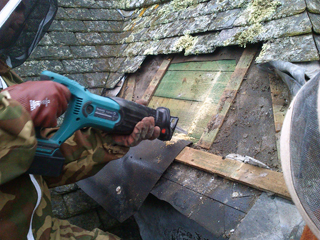 I make no apologies for starting this month’s blog with another reminder about the Asian Hornet which has recently arrived on our shores from France. In addition to the initial sighting of this exotic pest in the Tetbury area of Gloucestershire, there were further sightings in six locations within 500m of the original site. Bee Inspectors were deployed across a 5km surveillance area around Tetbury, inspected 100 local apiaries to look for any characteristic “hawking” behaviour in front of hives, and handed out hornet monitoring traps to local beekeepers in the area.
I make no apologies for starting this month’s blog with another reminder about the Asian Hornet which has recently arrived on our shores from France. In addition to the initial sighting of this exotic pest in the Tetbury area of Gloucestershire, there were further sightings in six locations within 500m of the original site. Bee Inspectors were deployed across a 5km surveillance area around Tetbury, inspected 100 local apiaries to look for any characteristic “hawking” behaviour in front of hives, and handed out hornet monitoring traps to local beekeepers in the area.
I have had one of these devices in my apiary for the past 2 years as part of the “Sentinel Apiary” programme, of which I am a part, where beekeepers with hives located at likely ingress points for exotic pests have been monitoring for such occurrences. So far, no sightings to report on the Roseland – and long may that continue to be the case – but the finding of the nest in the Tetbury area suggests the pests had been here for several months before being sighted.
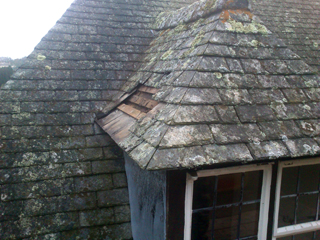 However, a further sighting has been verified north of the Mendip Hills in Somerset, where an Asian Hornet was found in a wasp trap. A repeat of the Gloucestershire exercise has been undertaken with local control centres and surveillance areas established, though nothing has been found so far. I’ve also heard via third parties of sightings near Wellington/Cullompton and in the Hayle area, but there has been no confirmation so far of these reports.
However, a further sighting has been verified north of the Mendip Hills in Somerset, where an Asian Hornet was found in a wasp trap. A repeat of the Gloucestershire exercise has been undertaken with local control centres and surveillance areas established, though nothing has been found so far. I’ve also heard via third parties of sightings near Wellington/Cullompton and in the Hayle area, but there has been no confirmation so far of these reports.
It just means we must all be on the lookout for these hornets, as they can crop up anywhere by the look of it – and surprisingly not where we might have expected to see them first, eg Dover or elsewhere on the south coast nearest to France. It suggests that a) the hornets didn’t get here by flying and b) they are coming in by road rather than by sea. It could even be a single mated queen who hibernated in a container or plant pot of some sort being brought in and then establishing its nest alone, as is their habit.
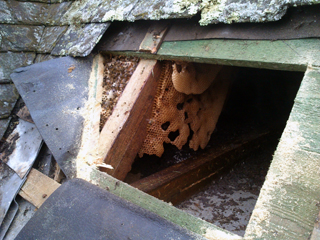 On a more usual beekeeping note, I have been involved lately in attempting to remove a colony of bees from the dormer roof of a listed building. The roof has had bees in residence on and off for the past 3 years or so and each time they were spotted, I have been contacted about them.
On a more usual beekeeping note, I have been involved lately in attempting to remove a colony of bees from the dormer roof of a listed building. The roof has had bees in residence on and off for the past 3 years or so and each time they were spotted, I have been contacted about them.
I then spelled out the problems of removal without damage to the property – even looking to see if they could be removed through the ceiling from inside the property – but nothing ever came of it, as permission was required to remove the slates from the roof. On two occasions, pest controllers were employed to kill the bees – but the bees’ access to the roof space was never blocked off, so new swarms arrived and took up residence! Finally, a decision has been made to physically remove them, rather than kill them, so a builder was contacted and I was asked to attend.
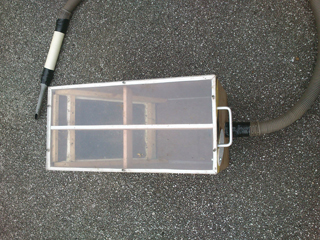 The dormer roof is so small that even after removing several rows of slates and cutting away the wooden boarding underneath, my access was still restricted by two rafters coming down from the ridge board, such that I could only reach in as far as my arm would stretch to cut out the comb.
The dormer roof is so small that even after removing several rows of slates and cutting away the wooden boarding underneath, my access was still restricted by two rafters coming down from the ridge board, such that I could only reach in as far as my arm would stretch to cut out the comb.
This meant that, whilst I was able, finally, to remove the comb, there still remained a fair amount of wax where the comb was attached to the wooden rafters and ridge board – which would prove an attractant to further swarms in the future. But did I get the bees? Not so far! They left the combs as I was cutting them out and were insistent on clustering in the deepest, darkest recess of the dormer roof which is beyond my reach!
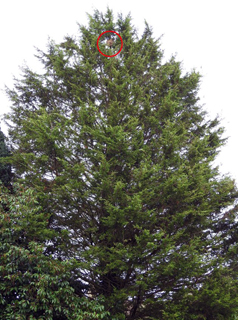 Luckily we had a meeting of the Roseland Beekeeping Group on Thursday last week where I was offered the use of a “bee-vac” to suck the bees out – a ploy which has worked in many previous situations. So I thought about it overnight, then phoned the holder of the “bee-vac” next day, collected it, then modified it for use with my vacuum cleaner.
Luckily we had a meeting of the Roseland Beekeeping Group on Thursday last week where I was offered the use of a “bee-vac” to suck the bees out – a ploy which has worked in many previous situations. So I thought about it overnight, then phoned the holder of the “bee-vac” next day, collected it, then modified it for use with my vacuum cleaner.
I then returned to the bees and proceeded to suck them out of their lair. Unfortunately, there were still many who did not want to play ball, so I took away the bees I had and whilst putting them in a new hive identified the fact that there was no queen. This means that those bees left will still have their queen with them and will not come out.
My next ploy will be to use a frame of open brood from one of my home colonies as an attractant (bees are drawn to look after open brood like iron filings to a magnet), so that once the queen is “on board” the frame can be placed in a nucleus hive and transported to the hive where the first lot of bees are installed and there will be no bees left in the roof. I will keep you posted on developments!
 The rest of the bees at my apiaries at home and away have all been busy bringing in ivy nectar and pollen, filling up their larders in readiness for the winter ahead. One or two of them are bringing in a surplus that I will eventually be able to remove for my own use but there certainly seems to be plenty available for their own needs.
The rest of the bees at my apiaries at home and away have all been busy bringing in ivy nectar and pollen, filling up their larders in readiness for the winter ahead. One or two of them are bringing in a surplus that I will eventually be able to remove for my own use but there certainly seems to be plenty available for their own needs.
The down side is that with such a long period of ivy flow, is Mother Nature trying to tell us something about the winter ahead? I sincerely hope so, because we haven’t had a really cold winter for a few years now – wet and cold, but never freezing, which is what we really need to kill off the bugs and suchlike that cause problems to both man and beast. Keep your fingers crossed – and keep looking up into the tallest evergreen trees you have in your area for the sight of an Asian Hornet nest hidden amongst the foliage – they’re likely to be here before long!
Colin Rees 01872 501313 colinbeeman@aol.com

